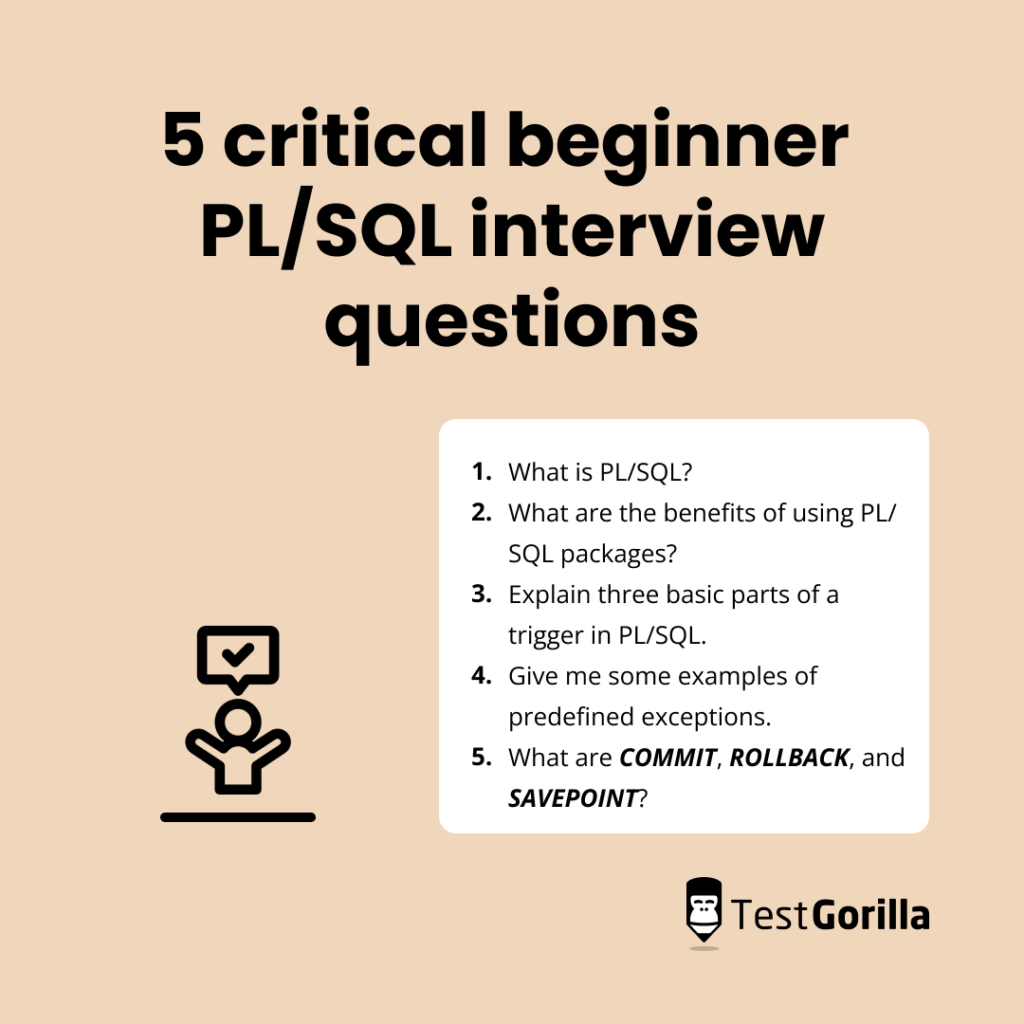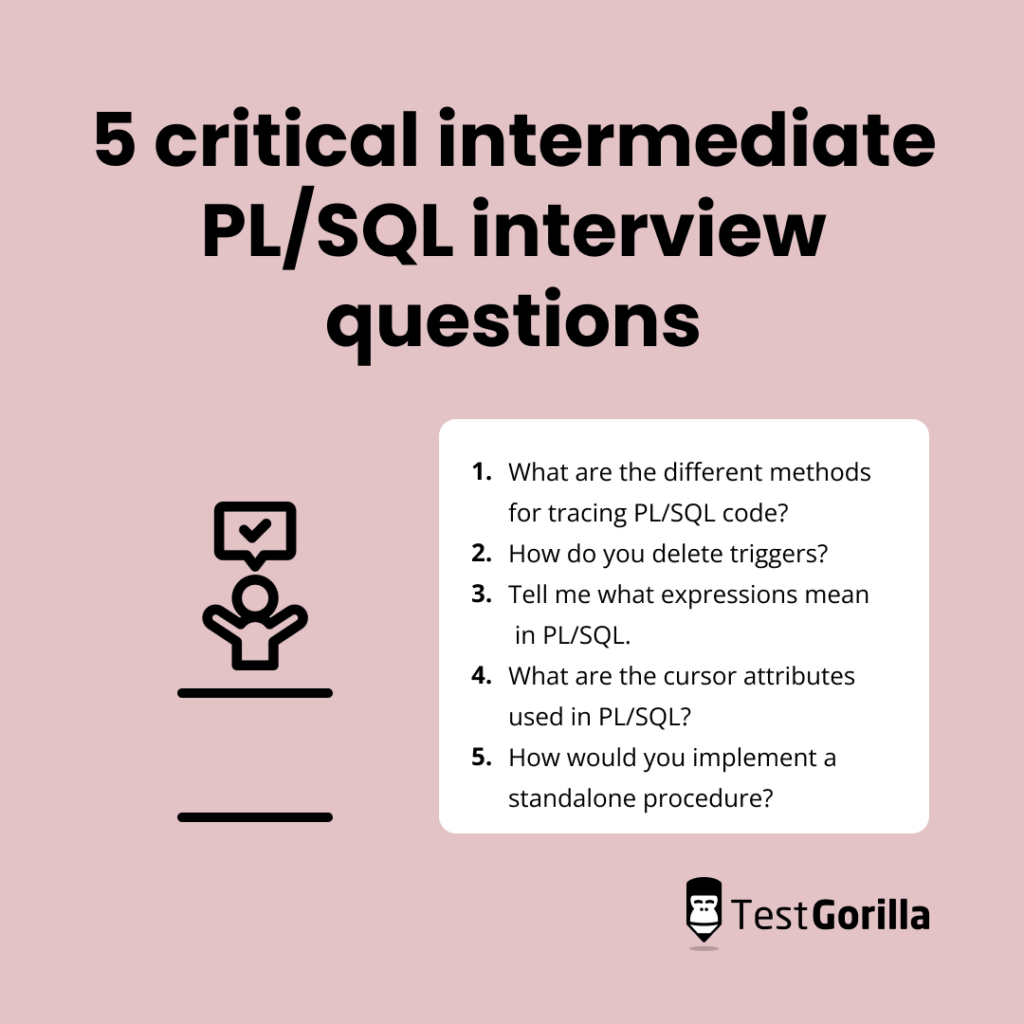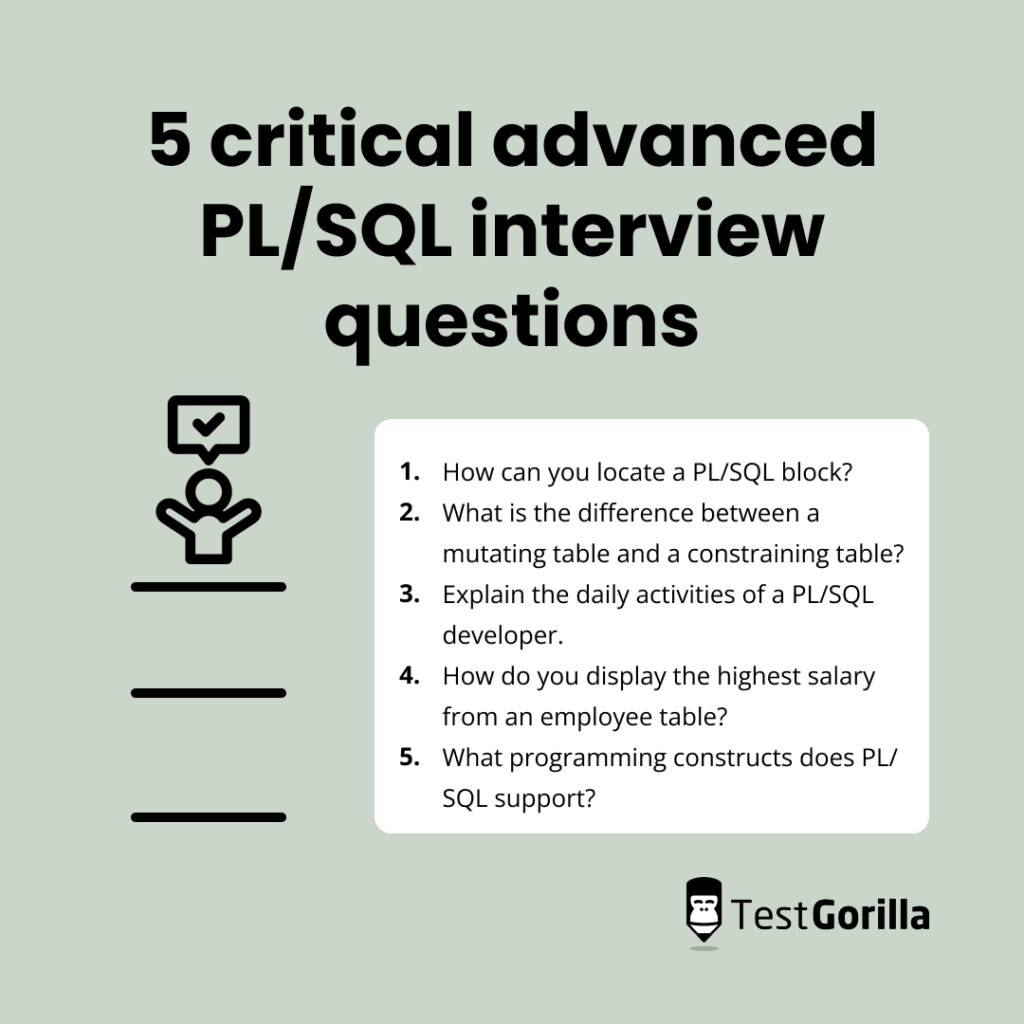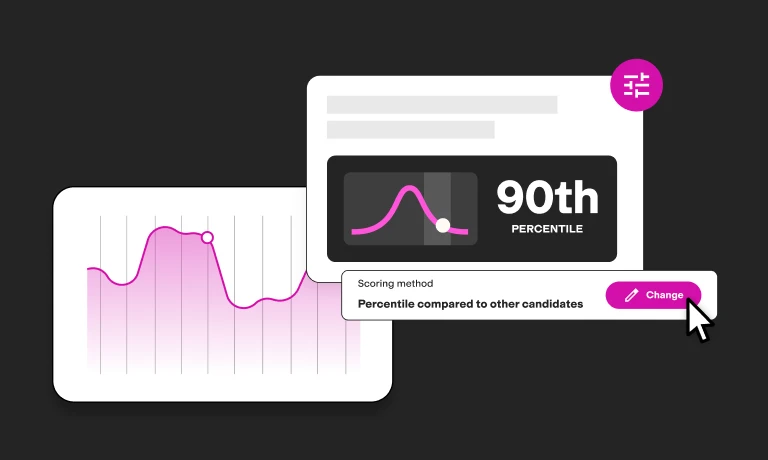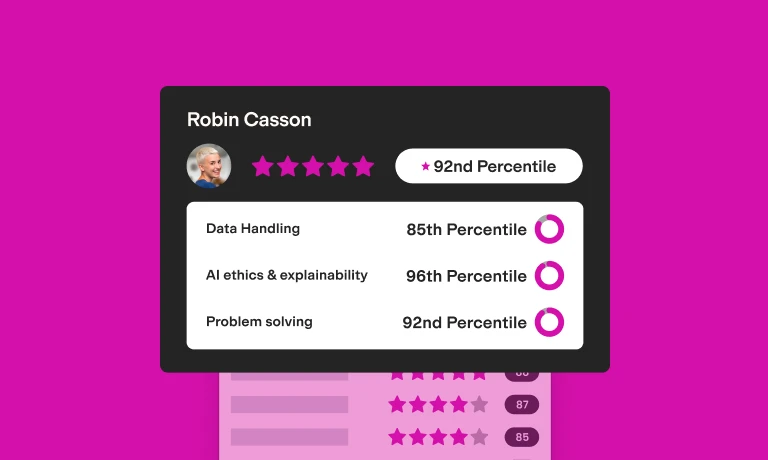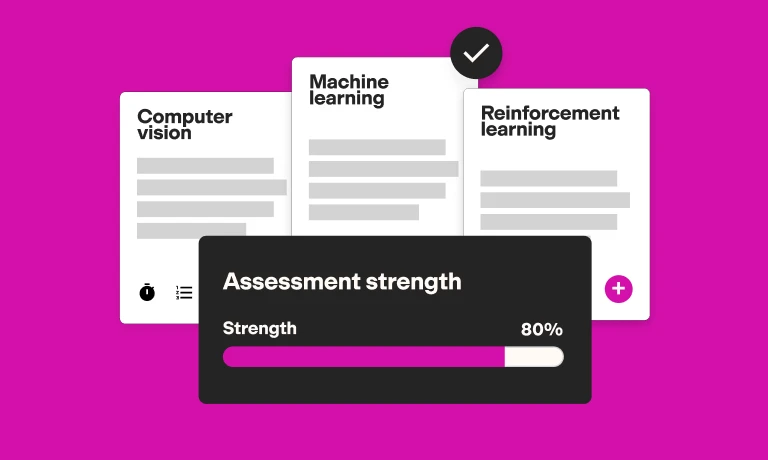75 PL/SQL interview questions to ask job applicants with programming skills
The demand for technical skills is always increasing. In recent years, more and more jobs in the programming field have become available. But to fill these roles, developers need various programming skills.
One key programming language is PL/SQL, an extension of Oracle’s Structured Query Language (SQL) that aims to improve the efficiency of procedural programming. It helps computer professionals change and transform information in the company’s database.
PL/SQL is a complicated system, so if you need to hire a PL/SQL developer, it’s important to find candidates with the right skills, experience, and knowledge to navigate the language. To assess candidates, you can send them an Oracle DBMS test and ask engaging interview questions.
Not sure which questions to ask?
Try using some of the PL/SQL interview questions below to evaluate your candidates’ technical skills and programming knowledge.
Table of contents
- 25 beginner PL/SQL interview questions for programmers
- 5 critical beginner PL/SQL interview questions and answers
- 25 intermediate PL/SQL interview questions
- 5 critical intermediate PL/SQL interview questions and answers
- 25 advanced PL/SQL interview questions
- 5 critical advanced PL/SQL interview questions and answers
- For what kinds of roles can you use PL/SQL interview questions?
- Why you should send candidates skills tests before using PL/SQL interview questions
- Hire professional computer programmers using skills assessments and PL/SQL interview questions
25 beginner PL/SQL interview questions for programmers
There are more than 173,161 junior developers in the United States alone. Statistics show that around 21% of software developers worldwide have zero to four years of web development experience.
With such a pool of junior talent, you’ll need a reliable method to pinpoint the most promising applicants. Check out these beginner PL/SQL interview questions to better understand entry-level candidates.
1. What is PL/SQL?
2. Compare SQL and PL/SQL.
3. Do you know the basic structure of PL/SQL?
4. What is a trigger? How do you use it?
5. What data types does PL/SQL have?
6. Explain the PL/SQL compilation process.
7. Tell me what a package consists of.
8. What are the benefits of using PL/SQL packages?
9. Do you understand the meaning of exception handling?
10. Give me some examples of predefined exceptions.
11. What do you understand by PL/SQL cursors?
12. When do we use triggers?
13. What is a PL/SQL block?
14. Name the differences between syntax and runtime errors.
15. What are COMMIT, ROLLBACK, and SAVEPOINT?
16. What are the two types of exceptions?
17. Do you know what a mutating table error is?
18. When is a declaration statement required?
19. Explain three basic parts of a trigger in PL/SQL.
20. What are character functions?
21. What is the difference between type and rowtype?
22. Name some schema objects that are created in PL/SQL.
23. What is the purpose of sysdate and user keywords?
24. Are there any downsides to using PL/SQL?
25. How can we use comments in PL/SQL code?
5 critical beginner PL/SQL interview questions and answers
Refer to these beginner sample answers when comparing candidates’ responses after the interview.
1. What is PL/SQL?
Beginners should understand the basics of PL/SQL and how to use the language to complete specific tasks. They should be able to explain that PL/SQL is a database programming language that stands for Procedural Language extensions to Structured Query Language.
It is an extension of Oracle’s SQL database language. Developers can use this programming language to update information in relational database management systems.
Consider sending candidates a Clean Code test to learn more about their programming skills and ability to write clean and readable code. This test prompts them to write simple and understandable code and evaluates their knowledge of efficient implementation strategies.
2. What are the benefits of using PL/SQL packages?
Every candidate should know about the benefits of using PL/SQL packages. These are named collections of functions that relate to variables and constants. Give candidates a bonus point if they explain the definition of packages in a programming language.
Here are some of the benefits of PL/SQL packages:
They provide the ability to keep information public or private in the organization’s database.
Developers can match the interface to the code in any package before designing other modules.
Programmers can decide how to structure data and modules.
Declared objects become global data for other objects in PL/SQL. You can change packages and refer to those modifications in another package.
Developers receive more transaction integrity compared with other languages.
They improve performance for relational database management systems, helping to validate objects in the database.
3. Explain three basic parts of a trigger in PL/SQL.
This is a straightforward question that shouldn’t require much thought. If candidates have experience with PL/SQL, they will understand how triggers function in this programming language.
Below are the three basic parts of a trigger in PL/SQL:
A triggering statement or event
A restriction
An action
Consider whether your applicants can explain why each of these parts is important before you hire them.
4. Give me some examples of predefined exceptions.
Predefined exceptions occur when a PL/SQL program exceeds a system-dependent limit or disregards a specific rule. These error conditions often appear when a null object doesn’t have the right value. Candidates should understand the rules of PL/SQL and how to address different kinds of errors.
Here are a few examples of predefined exceptions:
NO_DATA_FOUND****: occurs when a SELECT INTO statement returns no data
TOO_MANY_ROWS****: happens when a SELECT INTO statement returns more than one row of data
INVALID_CURSOR****: means that a developer has used an illegal cursor operation, such as closing an unopened cursor
ZERO_DIVIDE****: occurs when a PL/SQL program attempts to divide a number by zero
Candidates can show their programming skills by discussing ways to solve these errors in PL/SQL.
5. What are COMMIT, ROLLBACK, and SAVEPOINT?
COMMIT, ROLLBACK, and SAVEPOINT are PL/SQL statements that manage transactions. Candidates should be able to explain each command and how to use it. Here are the definitions you should listen for:
COMMIT saves changes in a database during a transaction and makes them permanent
Developers can use ROLLBACK to undo modifications they made within a transaction
SAVEPOINT marks the current point in a transaction that you can roll back to
The best insights on HR and recruitment, delivered to your inbox.
Biweekly updates. No spam. Unsubscribe any time.
25 intermediate PL/SQL interview questions
Use these PL/SQL interview questions for candidates who have intermediate-level experience in and knowledge of this programming language.
1. How do you access the fields of a record in PL/SQL?
2. Can you label a PL/SQL loop?
3. What are the different methods for tracing PL/SQL code?
4. Why should you use an index in a table?
5. How do developers use database links?
6. Tell me what expressions mean in PL/SQL.
7. What is the overloading of a procedure?
8. Define a subprogram in PL/SQL.
9. How would you implement a standalone procedure?
10. Tell me how to declare a constant in PL/SQL.
11. Explain what the open cursor command function does.
12. How do you delete triggers?
13. What is the difference between temporary and permanent tablespaces?
14. Which command do developers use to delete a procedure?
15. What are the cursor attributes used in PL/SQL?
16. How do you declare a user-defined exception?
17. The case statement has no selector in PL/SQL. Is this true?
18. What is the difference between implicit and explicit cursors?
19. What are the benefits of triggers?
20. What are the found and not found cursor attributes in PL/SQL?
21. Can you explain the PL/SQL execution architecture?
22. What are the functions available for manipulating character data?
23. What virtual tables are available in PL/SQL?
24. What are PL/SQL records?
25. What are the three parameter modes in PL/SQL?
5 critical intermediate PL/SQL interview questions and answers
Below are intermediate interview questions and answers regarding PL/SQL and its main components.
1. What are the different methods for tracing PL/SQL code?
Candidates should explain that tracing code is an important technique in PL/SQL. It can measure the code’s performance during runtime and help developers gather data from programs.
There are a few methods that enable developers to trace code, but the main ones include the following:
DBMS_APPLICATION_INFO
DBMS_TRACE
DBMS_SESSION and DBMS_MONITOR
Trcsess and Tkprof
The ideal candidate will also understand the importance of clean code and how to use tracing commands to spot simple errors.
2. How do you delete triggers?
One subskill candidates should have is the ability to delete triggers.
This action requires developers to use the common drop trigger, which drops any triggers in the current database. It’s also important to have the administer database trigger system privilege when managing these sets of actions.
Send candidates a Reading Comprehension test to evaluate their analytical thinking when it comes to interpreting code. This test prompts candidates to process text in a short amount of time.
3. Tell me what expressions mean in PL/SQL.
Expressions in PL/SQL are a series of literals and variables. Developers can use operators to separate these expressions and manipulate and change data. Candidates may state that variables are split into operators and operands.
This may be a difficult question, but skilled candidates will know the meaning of literals, variables, and operators in PL/SQL and how they are written in a query language.
You can use pre-employment technical aptitude tests to better understand a candidate’s technical skills and knowledge.
For example, you might send them a Numerical Reasoning test to see how they interpret written information and complex data. Candidates should also understand number patterns and percentages, so check these skills with this test.
4. What are the cursor attributes used in PL/SQL?
Cursor attributes are variables that control areas of a cursor in PL/SQL. You can use these pointers to evaluate rows and execute SQL commands. Understanding the four attributes is essential for navigating the programming language efficiently.
Below are the main cursor attributes used in PL/SQL.
%ISOPEN****: This attribute checks whether the cursor is in an active state.
%ROWCOUNT****: Programmers can use this attribute to check the number of updated, fetched, and deleted rows.
%FOUND****: Developers use this tool to check cursors against fetched rows. It will return TRUE if any rows were affected by a statement.
%NOT FOUND****: This is similar to the above attribute, except this cursor returns TRUE if no rows are affected by a statement.
5. How would you implement a standalone procedure?
A standalone procedure is a procedure that can be executed independently. You can store standalone procedures in the database to save specific actions. The ideal candidate will explain the steps of implementing a standalone procedure to achieve a given goal.
For example, they might mention that developers should use the CREATE PROCEDURE statement or REPLACE function to create new functions in the programming language.
25 advanced PL/SQL interview questions
Ask these advanced PL/SQL interview questions to hire experienced and knowledgeable talent for the open position.
1. What are pseudocolumns, and how do they work?
2. What is the difference between SQLCODE and SQLERRM?
3. Explain the daily activities of a PL/SQL developer.
4. How can you locate a PL/SQL block?
5. What is a join?
6. How do you display the highest salary from an employee table?
7. Tell me how you would create a nested table.
8. What is the difference between a mutating table and a constraining table?
9. How do you create a function in PL/SQL?
10. What programming constructs does PL/SQL support?
11. Explain what a timestamp data type is in PL/SQL.
12. How do you include single quotes in a string literal in PL/SQL?
13. What does the error ORA-03113 mean?
14. What is an autonomous transaction?
15. How can you debug your PL/SQL code?
16. How will you restrict the string length in PL/SQL?
17. Tell me about the role of a hierarchical profiler.
18. What are the roles of PLVrb and PLVcmt in PL/SQL?
19. How do you get returns on more than one row?
20. Describe a problem developers might face while writing log information in a database table in PL/SQL.
21. How can you verify whether a CPU has executed an update statement?
22. What do you know about PRAGMA EXCEPTION_INIT in PL/SQL?
23. Which command deletes a package in PL/SQL?
24. What is the purpose of the DBMS_OUTPUT package?
25. What is a subquery? Name some types of subqueries in PL/SQL.
5 critical advanced PL/SQL interview questions and answers
Come back to these sample answers when you compare responses to help choose candidates to move forward in your hiring process.
1. How can you locate a PL/SQL block?
Developers can locate a PL/SQL block by using the %ISOPEN variable cursor. A block is the basic program unit in a programming language, so programmers need to understand this concept to declare code properly.
Experienced candidates should also know that blocks revolve around the keywords DECLARE, BEGIN, EXCEPTION, and END. These keywords define and partition each block.
2. What is the difference between a mutating table and a constraining table?
A mutating table is a table that is being changed by a data manipulation language (DML) statement. You might also create this table using defined triggers. Top answers may mention that many developers encounter the common mutating error because they are trying to examine a statement that is already being modified.
On the other hand, a constraining table enforces referential integrity. Candidates should know that constraints are rules for a table and its columns. They may use INSERT, UPDATE, or DELETE statements to create this table. The data developers put into this table is also limited based on the rows.
3. Explain the daily activities of a PL/SQL developer.
Developers complete many tasks using the PL/SQL language. The specific activities they work on depend on their programming language skills and objectives. Experienced candidates should fully understand the job role and the responsibilities it entails. Make a note of each response to determine which candidate has the most knowledge.
Here are some of a PL/SQL developer’s daily activities:
Create database objects, tables, statements, and sequences
Implement procedures and functions in a program
Declare business constraints and resolve triggers
Create cursors for data manipulation
Experiment with different cursor attributes
Support arrays using PL/SQL collections
Develop applications for a programming language strategy
4. How do you display the highest salary from an employee table?
You can display the highest salary from an employee table by displaying the employee’s name and checking the following query:
Select max(sal) from emp;
This code should tell you the employee’s exact number. To find the lowest salary, you must replace max with min to implement the right code in PL/SQL. Since this is a practical question, candidates can write down the answer or talk you through the steps of finding the highest salary.
5. What programming constructs does PL/SQL support?
Candidates should know what features and constructs PL/SQL supports. The more experience they have, the more capable they will be of completing day-to-day activities. If the candidate doesn’t understand these features, they may not have enough knowledge of programming in PL/SQL.
Below are some constructs that PL/SQL supports:
Variables and constants
Triggers
Cursor attribute management
Stored procedures and packaging
SQL support
Flow control
Exception management
Loops, statements, and assignments
Object-oriented programming
Send candidates an Object Oriented Programming test to determine whether they can handle basic data types, variables, control flow, objects, and classes. This test will identify high-quality applicants who have strong programming skills.
For what kinds of roles can you use PL/SQL interview questions?
You can use PL/SQL interview questions for software developers, computer programmers, and PL/SQL developers who specialize in this procedural language. Many technical roles involve using specific programming languages, so it’s worth asking these questions to hire talented computer professionals.
SQL is one of the most in-demand skills in the technology industry. Therefore, you should always have a list of interview questions ready to ask candidates when interviewing for these technical roles.
Make sure to use relevant skills assessments before asking interview questions to identify high-quality applicants for the job.
Why you should send candidates skills tests before using PL/SQL interview questions
There are currently more than 47,810 PL/SQL developers in the United States. Therefore, you need a reliable way of screening developers before you begin the interview stage of your hiring process.
We recommend you send candidates relevant skills tests before the interviewing process. These tests can determine whether job applicants have the required skills, knowledge, and experience for the open position.
For example, you can use an Attention to Detail test to evaluate if candidates can process information and identify errors in code.
Cognitive assessments are best for roles that demand focus, analytical skills, and reasoning abilities.
On the other hand, you should use personality tests like our Culture Add test to assess a candidate’s behaviors and organizational values. This test will help you find a candidate whose values align with your company’s while also bringing in new ideas and perspectives.
Hiring candidates for culture add will improve the diversity of your team, which has been shown to improve financial performance.
Once candidates have completed these tests, you can compare their responses and decide which ones to interview. It’s better to spend your time interviewing candidates who have proven experience with PL/SQL.
Hire professional computer programmers using skills assessments and PL/SQL interview questions
Are you looking for the best skills assessments?
Search through TestGorilla’s extensive test library to discover relevant tests for your candidates to complete. With data-driven results, you can choose experienced job applicants who are qualified for the open position in your business.
Our list of PL/SQL interview questions will also help you determine whether candidates are beginners, intermediate, or advanced. This makes it easier to narrow down job applicants and interview those who understand how to use PL/SQL at the required level.
Create a free account on TestGorilla to learn more about these assessments and how they can enhance your hiring process. You can also try a free 30-minute live demo to learn more about our skills tests.
You've scrolled this far
Why not try TestGorilla for free, and see what happens when you put skills first.


